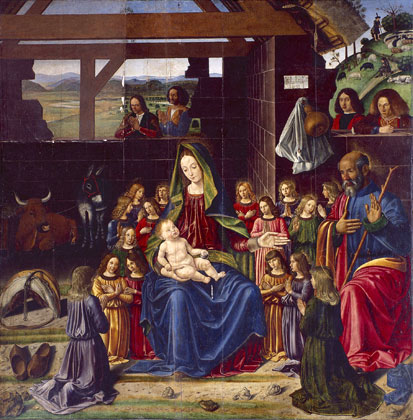Around the Aigueperse Saint Sebastian
Nothing is known about the circumstances of the commission and the initial destination of the imposing Saint Sebastian, acquired by the Louvre in 1910. It probably arrived at Aigueperse, in Auvergne, in the early years of 1480 on the occasion of the marriage, in 1481, of Gilbert de Bourbon-Montpensier (governor 1486-1496) and Chiara Gonzaga, daughter of Marquis Federico, perhaps as part of the exorbitant dowry given by her father. Nothing proves that it was painted for this precise event. In the 17th century it was described in praiseworthy terms in the Sainte-Chapelle, but the name of the artist was already forgotten.
Before leaving Mantua, Mantegna’s Saint Sebastian seems to have impressed Bernardino da Parenzo who transposed the composition and the décor of antique ruins onto his small panel. It was rather in Auvergne that it was perhaps admired by Antonio Maineri, a painter active in Bologna, who left, if one can believe the documents, to rejoin Gilbert de Bourbon in 1481.
The commission in 1490 of a Nativity from Benedetto Ghirlandaio—who we know was absent, in France—illustrates well the Italianizing taste at the court of Auvergne. However, this pleasant painting, of an anecdotal inspiration, is at the antipodes of the monumentality, of the antique vein and the theatrical effects of Mantegna’s Saint Sebastian.
From the Camera degli Sposi to Rome
After the completion of the Camera degli Sposi (1474), and even after the death of his old friend Ludovico Gonzaga (1478), Mantegna’s reputation was considerable. Marquis Ludovico’s successors, Federico and Francesco II, gave him their entire confidence and the rhythm of commissions did not weaken.
At the end of the 1480s, Pope Innocent VIII called upon him to decorate his chapel in the Belvedere of the Vatican, his new residence. Marquis Francesco accepted this absence and the artist stayed in the Eternal City for almost two years, from 1488 to 1490.
For one who had spent his youth dreaming of Antiquity, the confrontation with the Roman ruins should have provided an extraordinary opportunity to deepen his archaeological knowledge and to renew his approach. In fact, things did not work out that way, in spite of the honors which were lavished on him, this man aged about sixty, felt exiled.
Works showing his fascination with the Antique past are sometimes associated with the period 1485-1490. The Virgin and Child with Saints Zaccharia and Elisabeth evokes, in the hieratic presentation of the personages placed as in a frieze, a Roman funerary relief. In the same way, the tragic figure of Christ held by two angels, is placed against a sky at sunrise, and is seated on a sumptuous antique-style sarcophagus of porphyry. The admirable white shroud is one of the painter’s finest pieces of painting.
Benedetto Bigordi, known as Ghirlandaio (Florence, circa 1458 - Florence, 1497)
The Nativity
1490
Wood; H. 1.47 m; W. 1.47 m
Aigueperse, Eglise Notre-Dame, IM63001643
© Sparsae, Association culturelle d'Aigueperse et ses environs.






